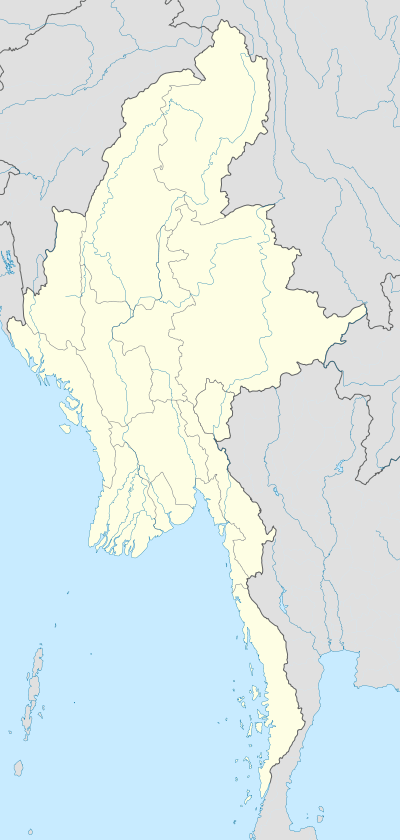Tedim
| Tedim Tiddim | |
|---|---|
 Tedim Location in Burma | |
| Coordinates: 23°22′33″N 93°39′14″E / 23.37583°N 93.65389°ECoordinates: 23°22′33″N 93°39′14″E / 23.37583°N 93.65389°E | |
| Country |
|
| Division | Chin State |
| District | Falam District |
| Government | |
| • Ukpi, Mangpi, Thuzekpi, | Currently not available |
| Population | |
| • | Population 89,000 |
| • Religions | Christian |
| Time zone | MST (UTC+6:30) |
Tedim (Burmese: တီတိန်မြို့; Official name Tiddim) is a town in and the administrative seat of Tedim Township, Chin State, in the north-western part of Burma. It is the largest town in Chin State. The town's four major boroughs (veng) are: Sakollam, Myoma, Lawibual and Leilum.[1][2] The population is primarily Zomi.[3]
History
The name "Tedim" was derived from a pool up in the hills that used to twinkle in the sunlight, therefore it was called "te (bright, shine)" and "dim (twinkling, sparkling)" in the local Zomi language.
As the Zomi lacked a formal writing system in the past, the story of Tedim mostly depends on oral tradition. Establishment of Tedim is ascribed to Gui Mang II, a powerful prince from the then ruling Guite family in the region (c. 1600). However, due to the untimely death of Gui Lun (the fifth generation from Gui Mang II), Tedim was deserted for two generations. By the time of Pum Go, Tedim was reestablished as the political base of the Guite family. At the time of Mang Suum II, son of Pum Go, the allied force of the Pawihangs began their advance in the region and attacked Tedim. Tedim was again deserted by many, though some local residents survived under the leadership of Mang Gin from the Hatlang family.[4] In 1840, in order to secure peace, the remaining citizens invited the leadership of Kam Hau of Mualbem, of the emerging Sukte family, since they had good military and political ties with the Zahau family of the Pawis.[5]
When British rule began in 1824, Tedim was chosen as the local residence for the District Officer.
Geography
The ranges of Hills of Thangmual include Kennedy's Peak, Lunglenkawl, the Rih Bual, the Hausapi, the Gullu Mual, the Zangmualli, the Tuikangpi, the Suangsuang, and the Lentangmual. There are dams, caves, peaks, and other attractions, including Lennupa Mual, the Twin Fairy Hill, and historic sites.
References
- ↑ Thang Mu An (5 April 2016). "Tedim Ah Innthak Khan Cihtak In Khang". Zomi News Journal (in Zomi). Archived from the original on 9 June 2016.
- ↑ "Tedim Khuapi tangthu leh Limlaak tuamtuam te". Laibu Saal (in Zomi). August 2014. Archived from the original on 9 June 2016.
- ↑ Zomi include the Kuki (Thados), the Manipur (Meitei and Paite), the Lusei (Mizo), the Laimi (Khalkha or Hakha and Thangtlang), and the Falam (Pawite).
- ↑ C. 1820, by C. Tuan.
- ↑ Sing K. Khai, Zo People and Their Culture (Lamka, Churachanpur, India: Kampu Hatzaw, 1995), 25-27 (Khai comments on the emergence of the Sukte family as a matter of fear of the Pawis of present Falam, that Khan Thuam and his son, Kam Hau, ruled as their vassal).
External links
- Vaphual News in Tedim
- Tedim Bible (free download)
- English to Tedim/Zolai Dictionary
- Zolai to English Dictionary and Zolai Grammar
- Zomi Online Library
